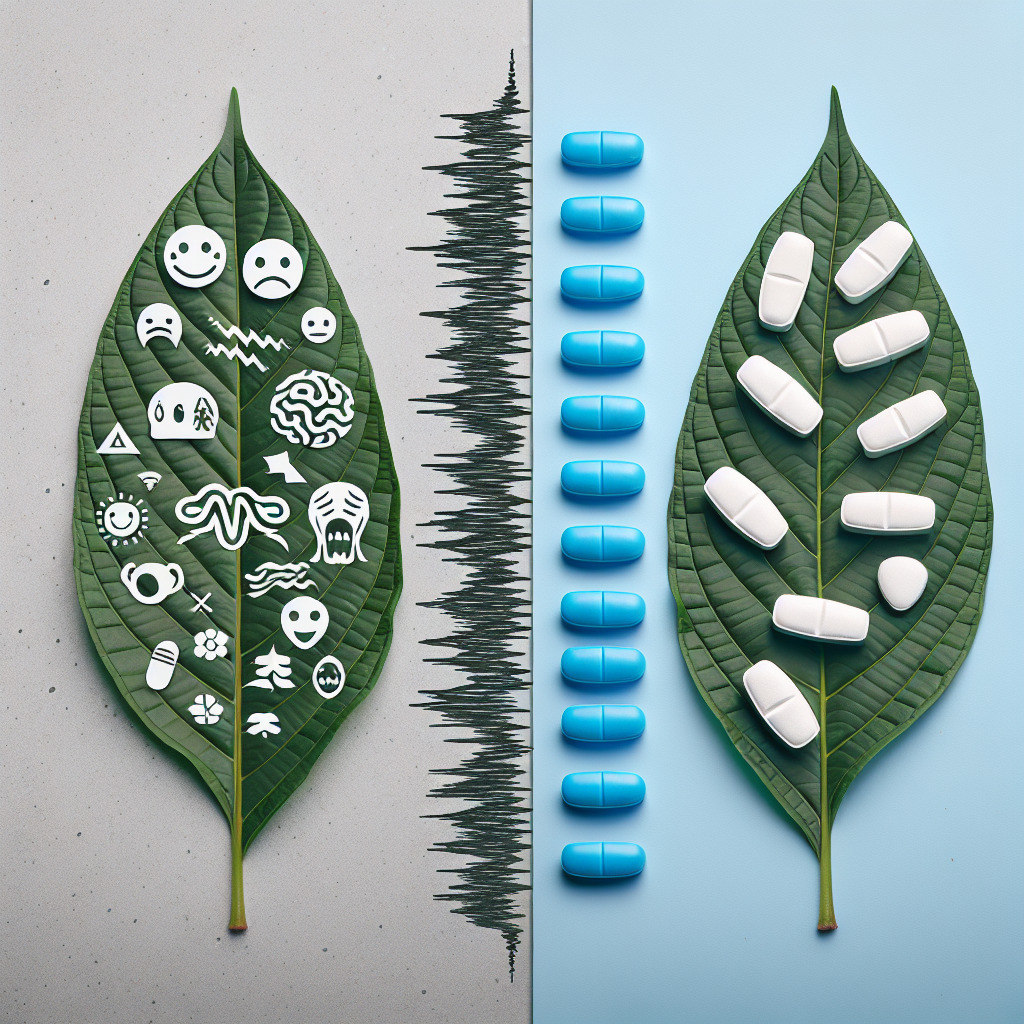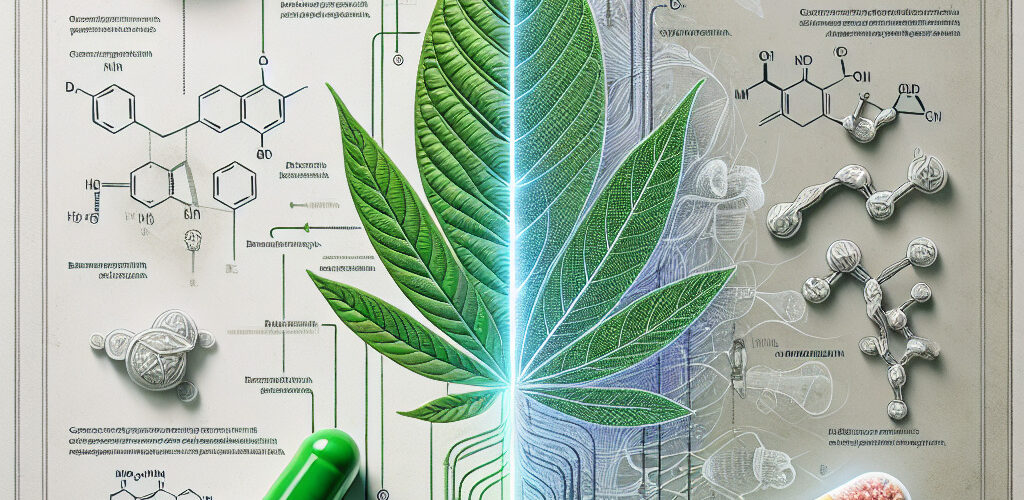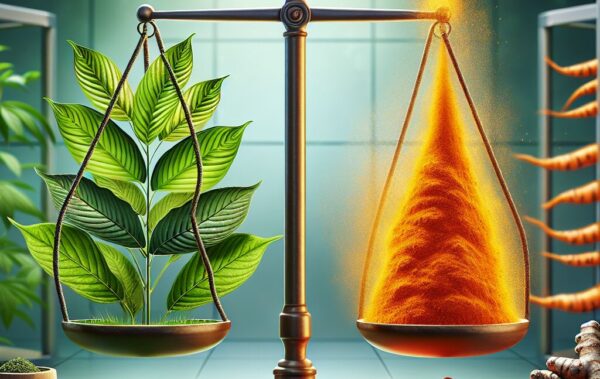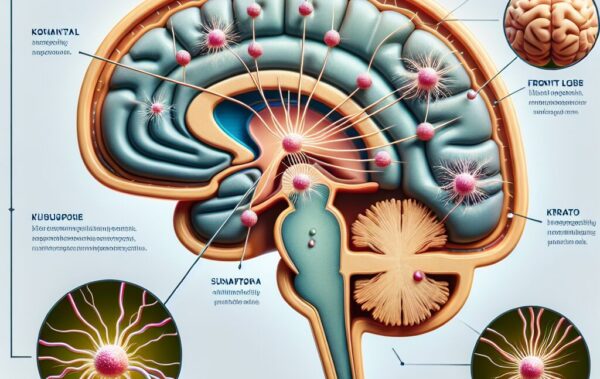- Overview of Kratom pharmacology and use
- Benzodiazepines in the treatment of anxiety
- Efficacy of Kratom in anxiety management
- Risks and side effects of Kratom versus benzodiazepines
- Comparative analysis and potential for combined therapy
Kratom, a plant native to Southeast Asia, has been traditionally used for its medicinal properties for centuries. In recent years, it has gained popularity in Western countries, including the United States, as individuals seek alternative treatments for a variety of conditions. One of Kratom’s primary uses is for the relief of anxiety, which often brings it into comparison with more conventional treatments like benzodiazepines.
Kratom’s pharmacology is quite unique; its active components are alkaloids, mainly mitragynine and 7-hydroxymitragynine. These compounds interact with the body’s opioid receptors but display a different profile of activity compared to traditional opioids. This interaction can result in sedative effects at higher doses, which may be beneficial for those suffering from anxiety, stress, and difficulty sleeping. At lower doses, Kratom can have a stimulating effect, which some users report helps alleviate the lethargy sometimes associated with anxiety.
The consumption of Kratom comes in several forms—the most popular of which include Kratom powders and capsules. Users typically ingest the powder through “toss and wash,” adding it to beverages, or by consuming capsules for easier dosing and a more palatable experience. Other forms are also available, such as extracts and edibles, which some users prefer for their convenience and strength.
While it is not officially sanctioned by the FDA for medical use, many attest to Kratom’s potential benefits in anxiety treatment. Its status, however, remains a subject of contention, with regulatory bodies expressing concerns over its safety profile and potential for dependence. Consumers typically source Kratom from specialized vendors or online platforms that provide a variety of strains, each purported to offer different effects.
Understanding the pharmacology of Kratom is crucial for those considering it as an option for anxiety relief. This natural botanical provides a different option from traditional sedatives such as benzodiazepines, which although effective, come with a significant risk of dependence and other side effects. The choice to use Kratom for anxiety treatment should come with careful consideration, acknowledging both its potential benefits and risks, which will be further explored in the following sections of this discussion.
Benzodiazepines in the treatment of anxiety
Benzodiazepines have long been prescribed as a frontline treatment for anxiety disorders and are among the most commonly used sedatives. Known for their fast-acting relief, they work by enhancing the effect of the neurotransmitter gamma-aminobutyric acid (GABA) in the brain, which results in a calming effect on the nervous system. This immediate sense of tranquility can be a godsend for someone in the throes of a panic attack or chronic anxiety.
The effectiveness of benzodiazepines in providing short-term relief from severe anxiety is widely recognized in the medical community. They can rapidly alleviate symptoms and are useful for treating acute anxiety episodes or as an adjunct therapy to other medications or psychotherapy in managing chronic anxiety conditions. The typical benzodiazepines used for these purposes include alprazolam (Xanax), lorazepam (Ativan), and diazepam (Valium).
Despite their efficacious nature in anxiety treatment, benzodiazepines come with a significant risk of dependence, especially when used long-term or inappropriately. This drug class can lead to tolerance, where the user may feel the need to take higher doses to achieve the same sedative effect, raising the risk of dependency and potential withdrawal symptoms upon cessation.
Another critical concern regarding benzodiazepines is their side effect profile. Common side effects include drowsiness, dizziness, impaired coordination, and sometimes, cognitive impairment. More severe risks may involve respiratory depression or the possibility of overdose, particularly when combined with other central nervous system depressants like alcohol.
Due to these concerns, healthcare providers often recommend using benzodiazepines for the shortest time possible and under strict medical supervision. Cognitive-behavioral therapy (CBT) and other non-pharmacological interventions are also advocated to manage anxiety as a sustainable alternative to long-term benzodiazepine use. It’s imperative for patients to weigh the risks and benefits and have an open dialogue with their healthcare provider before starting any medication regimen.
Those considering alternatives to benzodiazepines may look into natural options, such as Kratom, which some propose as a less habit-forming choice. The following sections will delve further into the efficacy of Kratom in managing anxiety and will compare its risk and side effect profile to that of benzodiazepines.
Efficacy of Kratom in anxiety management
Transitioning from the established medical treatment using benzodiazepines, the exploration into Kratom as an anxiety management tool is gaining traction among those looking for alternative or complementary therapies. Advocates of Kratom suggest that it possesses anxiolytic properties that may help manage symptoms of anxiety effectively. A significant number of anecdotal reports and a gradually growing body of research underline Kratom’s potential in this realm.
Anecdotal evidence suggests that many individuals have turned to Kratom to cope with their anxiety, praising its ability to promote a sense of calm and well-being without the intense sedation or potential for dependence that benzodiazepines carry. The debate over Kratom’s efficacy for anxiety treatment hinges not only on user experiences but also on an understanding of how its alkaloids may interact with the brain’s receptors. These interactions potentially mimic the action of benzodiazepines on GABA pathways, albeit through a different mechanism, which may account for the reported anxiolytic effects.
Key points to consider regarding the efficacy of Kratom for anxiety management include:
- Spectrum of Strain Effects: Kratom is available in a variety of strains, with differences in alkaloid profiles. For instance, individuals may turn to Red Vein Kratom strains for their sedative qualities, which can be relevant for anxiety sufferers seeking relaxation and improved sleep.
- Flexibility in Dosage: With Kratom, users can tailor their doses according to their needs. Lower doses may provide stimulating effects that can reduce the fatigue often associated with anxiety, while higher doses tend to offer more pronounced sedative effects.
- Reduced Risk of Over-Sedation: Although high doses of Kratom can induce a state of sedation, the risk of over-sedation is generally perceived to be lower compared to benzodiazepines, given that Kratom does not depress the respiratory system to the same degree.
- Dependence and Tolerance: While Kratom carries its own risk of tolerance and dependence, these risks are often viewed as less than those associated with long-term benzodiazepine use. Kratom users typically manage tolerance by rotating strains or limiting frequency of use.
What is less discussed, but equally important, is the subjective experience that Kratom offers. Unlike the clinical, prescription-based approach with benzodiazepines, Kratom users often report a more engaged and personal relationship with their usage. This may include experimentation with different forms of Kratom, be it powders, capsules, tea bags, or liquid extracts, to achieve desired outcomes.
Furthermore, many users value the ability to adapt their use of Kratom in line with their lifestyle and needs, which some regard as empowering—enabling a more holistic approach to anxiety management. However, without formal medical guidance and dosage standards, this self-directed approach can produce variable results.
Although anecdotal accounts of Kratom’s benefits are abundantly shared online, robust clinical studies confirming its efficacy and safety for anxiety treatment are sparse. One cannot disregard the placebo effect as a variable in user experiences, nor the potential for biased reporting. Moreover, the lack of regulation poses challenges to the consistency and purity of Kratom products, which could influence efficacy and side effects.
In summary, the potential of Kratom to manage anxiety is reported by many users, but its efficacy remains a subject that requires further rigorous scientific investigation. Its comparison to benzodiazepines is understandably based on its perceived potential for a lower dependence risk and fewer side effects. However, the decision to use Kratom for anxiety should be made with prudence, an understanding of potential legal implications, and ideally, under the guidance of a healthcare professional. The following sections will address these concerns by evaluating the risks, side effects, and the possibility of combining Kratom with other treatments for a more comprehensive approach to anxiety management.
Risks and side effects of Kratom versus benzodiazepines
 When discussing the risks and side effects of Kratom in comparison to benzodiazepines for anxiety treatment, it is important to adopt a cautious approach considering both substances carry their own unique sets of concerns. While many seek Kratom as an alternative to conventional pharmaceuticals, its safety profile is not fully understood, and its unregulated status raises questions about consistency and purity.
When discussing the risks and side effects of Kratom in comparison to benzodiazepines for anxiety treatment, it is important to adopt a cautious approach considering both substances carry their own unique sets of concerns. While many seek Kratom as an alternative to conventional pharmaceuticals, its safety profile is not fully understood, and its unregulated status raises questions about consistency and purity.
Kratom itself is not without risk. While it may act on opioid receptors, it does not do so in the same way as classical opioids or benzodiazepines. However, this does not mean its use is risk-free. Some of the reported side effects include nausea, itching, constipation, and in some cases, an elevated heart rate. More concerning reports have mentioned severe outcomes, such as liver toxicity with prolonged or heavy use, and a rare but serious condition called intrahepatic cholestasis, which can lead to jaundice.
Dependence is another significant risk associated with Kratom, albeit often deemed less severe than that associated with benzodiazepines. Regular use of Kratom can lead to tolerance, where the user requires larger doses to achieve the same effect which can pave the way for dependence. Withdrawal symptoms from Kratom can include irritability, muscle aches, emotional changes, and insomnia, suggesting potential physical dependence in some users.
On the other hand, benzodiazepines, known for their efficacy as sedatives, present a well-documented risk profile. They effectively mitigate the symptoms of severe anxiety but can lead to dependence after as little as a few weeks of use. The withdrawal process from benzodiazepines is also well-known for being particularly difficult, and in some cases, even life-threatening with symptoms like seizures, tremors, and profound anxiety.
Comparing risks and side effects of both, one should consider the likelihood and the duration of use. Due to the addictive nature of benzodiazepines, they are typically prescribed for short-term use, whereas Kratom, because of its legal accessibility and herbal status, may be used over longer periods, which could potentially lead to unforeseen long-term effects.
In terms of legal status, Kratom faces regulatory challenges across various jurisdictions. In some areas, it is classified as a controlled substance, similar to benzodiazepines, which are prescription-only medications. These legal restrictions reflect concerns over the misuse potential of Kratom and its potential public health risks.
Given the evolving nature of research on Kratom, users should remain vigilant and informed about their choices. Many users purchase Kratom online from reputable vendors who can provide lab-tested products for quality assurance. For example, those interested might look into trusted online marketplace platforms that aggregate Kratom products from various vetted brands, allowing for more informed purchase decisions.
When choosing to use either Kratom or benzodiazepines for anxiety treatment, individuals must consider the potential for negative interactions with other substances. Caution must also be exercised to prevent misuse, which could exacerbate side effects and increase the risk of dependence. Whichever path an individual decides to take, the importance of monitoring effects, and seeking guidance from healthcare professionals cannot be understated.
As such, those considering Kratom for anxiety must proceed with caution, keeping abreast of the latest research and regulatory updates. Users should also practice responsible consumption, perhaps starting with low doses and monitoring their response. Transparency about Kratom use with healthcare providers is also crucial, especially for those who may already be receiving treatment for anxiety or other medical conditions.
Ultimately, both Kratom and benzodiazepines offer benefits and potential drawbacks for anxiety treatment. The need for a balanced perspective, thorough personal research, and healthcare advice is paramount when considering either option.
Comparative analysis and potential for combined therapy
In the comparative analysis of Kratom and benzodiazepines for anxiety treatment, one must weigh the potential for combined therapy, addressing how these substances may interact and the circumstances under which co-use may be appropriate or advised against. In melding the more holistic, traditional approach of Kratom with the precise, medical model of benzodiazepines, a nuanced understanding of their pharmacodynamics, legal status, and patient-specific factors is paramount.
An interesting proposition for managing anxiety could lie in the strategic, complementary use of both Kratom and benzodiazepines. The sedative effects of benzodiazepines are often immediate and potent, making them a suitable option for acute anxiety episodes. Contrarily, Kratom might serve as a supplementary agent, possibly aiding those who wish to manage milder symptoms of anxiety or chronic states without the constant reliance on pharmaceutical sedatives that carry a heavier burden of dependence.
To consider a combined therapy approach, a number of factors must be carefully deliberated:
- Risk of Potentiation: Kratom and benzodiazepines could interact in unpredictable ways, potentially enhancing the sedative effects of each other. This can elevate the risk of over-sedation, impaired judgment, or respiratory depression even if Kratom alone does not significantly depress respiratory function.
- Monitoring and Adjustment: A combined regimen would necessitate vigilant monitoring for adverse effects and dose adjustment to mitigate the likelihood of developing tolerance to either substance, which could lead to dependence and an escalated risk of withdrawal challenges.
- Cross-Tolerance: Healthcare providers must consider the potential for cross-tolerance, where the body builds tolerance to one substance due to its similarity to another, necessitating higher dosages for the desired therapeutic effect.
- Legal and Ethical Considerations: Medical professionals should be cognizant of the legal status of Kratom, which remains unregulated or banned in some areas. Prescribing a controlled substance, like benzodiazepines, alongside an unapproved herb could lead to ethical considerations.
A potential outline for combined therapy may look like this:
- Conduct a thorough medical evaluation to determine the suitability of a combination approach for the individual, taking into account their medical history, current health status, and psychological evaluation.
- Initiate a low-dose benzodiazepine regimen for immediate relief during peak episodes of anxiety, ensuring responsible use under medical supervision to prevent dependence.
- Gradually introduce Kratom, possibly utilizing a strain like Green Vein Kratom known for its balanced effects, to support daytime anxiety management while assessing the patient’s reaction and ensuring no adverse interactions.
- Adjust benzodiazepines dosage down over time while monitoring Kratom use continuously, aiming to maintain anxiety control with minimal reliance on the pharmaceutical option.
- Continuously re-evaluate the therapeutic strategy, emphasizing consistent communication with the patient regarding their experiences and any side effects.
Of particular interest for those exploring this area of treatment is the potential role that certain forms of Kratom, like Kratom tea bags or liquid extracts, may play in this combined therapy framework. These forms allow for controlled dosing and a milder effect profile, which may be advantageous when blending treatments.
| Treatment Aspect | Considerations for Combined Therapy |
|---|---|
| Immediate Relief | Use short-acting benzodiazepines conservatively for acute anxiety attacks. |
| Chronic Management | Incorporate Kratom with caution, paying attention to potential interactions and dependence. |
| Dependency Risks | Assess and adjust therapy protocols to minimize the risk of tolerance and withdrawal. |
| Regulatory Status | Ensure compliance with legal requirements and medical standards for both substances. |
In combining these disparate treatments, one must recognize the balance of scientific evidence and anecdotal experiences. While benzodiazepines boast extensive clinical research validating their use in anxiety treatment, Kratom remains less understood, with a need for further empirical studies to substantiate its role in combined therapy settings.
Therefore, it is critical for individuals and healthcare providers to engage in open dialogue about the implications of using Kratom alongside benzodiazepines, considering existing regulations, research limitations, and patient wellbeing. Those considering this path should also be aware of their rights to informed consent, being fully aware of the potential risks and benefits of such a combined approach to anxiety treatment.
It is clear that while the combination of Kratom and benzodiazepines in treating anxiety suggests a promising avenue, particularly for those who have not found relief through conventional means, it requires a methodical, cautious approach, reserving such strategies for when they can be closely supervised by knowledgeable healthcare professionals.









